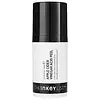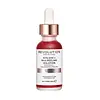The INKEY List Apple Cider Vinegar Acid Peel Versus Revolution Beauty 30% AHA + BHA Peeling Solution Intense Skin Exfoliator
What's inside
What's inside
 Key Ingredients
Key Ingredients

 Benefits
Benefits

 Concerns
Concerns

 Ingredients Side-by-side
Ingredients Side-by-side

Water
Skin ConditioningGlycolic Acid
BufferingGlycerin
HumectantCaprylyl/Capryl Glucoside
CleansingPolysorbate 20
EmulsifyingVaccinium Myrtillus Fruit Extract
Skin ConditioningAcetum
Sodium Hydroxide
BufferingPropanediol
SolventXanthan Gum
EmulsifyingSaccharum Officinarum Extract
MoisturisingLactobacillus
Skin ConditioningPhenoxyethanol
PreservativeHippophae Rhamnoides Fruit Oil
Skin ProtectingSalix Alba Bark Extract
AstringentMaltodextrin
AbsorbentCitrus Aurantium Dulcis Fruit Extract
MaskingCitrus Limon Fruit Extract
MaskingCitronellyl Methylcrotonate
MaskingAcer Saccharum Extract
Skin ConditioningEthylhexylglycerin
Skin ConditioningLeuconostoc/Radish Root Ferment Filtrate
AntimicrobialBiosaccharide Gum-1
HumectantPhytic Acid
Agastache Mexicana Flower/Leaf/Stem Extract
Skin ConditioningWater, Glycolic Acid, Glycerin, Caprylyl/Capryl Glucoside, Polysorbate 20, Vaccinium Myrtillus Fruit Extract, Acetum, Sodium Hydroxide, Propanediol, Xanthan Gum, Saccharum Officinarum Extract, Lactobacillus, Phenoxyethanol, Hippophae Rhamnoides Fruit Oil, Salix Alba Bark Extract, Maltodextrin, Citrus Aurantium Dulcis Fruit Extract, Citrus Limon Fruit Extract, Citronellyl Methylcrotonate, Acer Saccharum Extract, Ethylhexylglycerin, Leuconostoc/Radish Root Ferment Filtrate, Biosaccharide Gum-1, Phytic Acid, Agastache Mexicana Flower/Leaf/Stem Extract
Water
Skin ConditioningLactic Acid
BufferingPropanediol
SolventVaccinium Myrtillus Fruit Extract
Skin ConditioningGlycolic Acid
BufferingGlycerin
HumectantSaccharum Officinarum Extract
MoisturisingButylene Glycol
HumectantSalicylic Acid
MaskingCitrus Aurantium Dulcis Fruit Extract
MaskingCitrus Limon Fruit Extract
MaskingDaucus Carota Sativa Root Extract
Skin ConditioningXanthan Gum
EmulsifyingAcer Saccharum Extract
Skin ConditioningSodium Benzoate
MaskingPotassium Sorbate
PreservativeDisodium EDTA
Tasmannia Lanceolata Fruit/Leaf Extract
AntioxidantWater, Lactic Acid, Propanediol, Vaccinium Myrtillus Fruit Extract, Glycolic Acid, Glycerin, Saccharum Officinarum Extract, Butylene Glycol, Salicylic Acid, Citrus Aurantium Dulcis Fruit Extract, Citrus Limon Fruit Extract, Daucus Carota Sativa Root Extract, Xanthan Gum, Acer Saccharum Extract, Sodium Benzoate, Potassium Sorbate, Disodium EDTA, Tasmannia Lanceolata Fruit/Leaf Extract
 Reviews
Reviews

Ingredients Explained
These ingredients are found in both products.
Ingredients higher up in an ingredient list are typically present in a larger amount.
We don't have a description for Acer Saccharum Extract yet.
Citrus Aurantium Dulcis Fruit Extract is more commonly known as the bitter orange. Native to Southeast Asia, this extract is commonly found in both cosmetics and foods.
The bitter orange possesses antibacterial and antioxidant properties.
It can also be mildly exfoliating due to the citric acid, an AHA.
Citrus fruits are rich in flavonoids, alkaloids, and vitamin C.
Learn more about Citrus Aurantium Dulcis Fruit ExtractCitrus Limon Fruit Extract comes from lemons. While lemon extract is exfoliating and antimicrobial, it can also cause skin sensitivity.
Lemons contains antioxidants, which may help with anti-aging. They are also rich in citric acid, an AHA.
And of course, lemons are rich in Vitamin C. Vitamin C helps with skin-brightening and increasing collagen production.
The acidity of lemons may work as an astringent for acne.
However, lemons can also cause skin sensitivity due to its limonene content. It can also increase photosensitivity, or sensitivity to the sun.
This ingredient is also used to add a lemon scent to products.
Learn more about Citrus Limon Fruit ExtractGlycerin is already naturally found in your skin. It helps moisturize and protect your skin.
A study from 2016 found glycerin to be more effective as a humectant than AHAs and hyaluronic acid.
As a humectant, it helps the skin stay hydrated by pulling moisture to your skin. The low molecular weight of glycerin allows it to pull moisture into the deeper layers of your skin.
Hydrated skin improves your skin barrier; Your skin barrier helps protect against irritants and bacteria.
Glycerin has also been found to have antimicrobial and antiviral properties. Due to these properties, glycerin is often used in wound and burn treatments.
In cosmetics, glycerin is usually derived from plants such as soybean or palm. However, it can also be sourced from animals, such as tallow or animal fat.
This ingredient is organic, colorless, odorless, and non-toxic.
Glycerin is the name for this ingredient in American English. British English uses Glycerol/Glycerine.
Learn more about GlycerinGlycolic Acid is arguably the most famous alpha hydroxy acid (AHA) with tons of research backing its benefits.
It is found naturally in sugar cane but the form used in skincare is usually synthetic for purity and stability.
Glycolic acid removes the top layer of dead skin cells to allow newer and fresher ones to emerge.
AHAs work by breaking down the structural “glue” that holds old skin cells in place. When that buildup is gone, your skin can renew itself more efficiently.
Research also shows glycolic acid stimulates collagen production, helping to firm and thicken the skin over time. This is one of its biggest advantages over other AHAs.
Overall, glycolic acid helps with:
Fun fact: Glycolic acid boosts skin hydration by helping it produce molecules that increase hyaluronic acid naturally.
To work best, glycolic acid products should have a pH between 3-4 (that’s where exfoliation is most effective but still gentle on skin).
The pH and concentration of a product are key to its effectiveness:
It is normal to feel a slight stinging sensation when using glycolic acid. This usually fades as your skin adjusts.
Because glycolic acid has the smallest molecular size in the AHA family, it can penetrate deeper, which enhances its effectiveness but also makes it more likely to irritate sensitive skin.
If your skin is very sensitive or prone to rosacea, glycolic acid may be too strong; in that case, try milder options like lactic acid or a PHA instead.
Recent studies suggest glycolic acid might even help protect against UV damage. But don’t skip sunscreen! Freshly exfoliated skin is more sensitive to the sun.
Glycolic acid is a skincare superstar. It smooths, brightens, hydrates, and firms the skin. Unless you’re highly sensitive, it’s well worth adding to your routine.
Read more about some other popular AHA's here:
Learn more about Glycolic AcidPropanediol is an all-star ingredient. It softens, hydrates, and smooths the skin.
It’s often used to:
Propanediol is not likely to cause sensitivity and considered safe to use. It is derived from corn or petroleum with a clear color and no scent.
Learn more about PropanediolThis ingredient is also called sugarcane extract. It is a moisturizing humectant and has skin soothing properties.
Similar to hyaluronic acid, sugarcane can attract moisture to your skin.
Glycolic acid is a derivative of sugarcane. While glycolic acid is an AHA with exfoliating properties, sugarcane is not an AHA.
A study from 2021 found the compounds in sugarcane extract to have antioxidant, antimicrobial, and anti-inflammatory activity. The study also suggests these compounds can inhibit skin ageing enzymes and promote collagen synthesis.
Learn more about Saccharum Officinarum ExtractVaccinium Myrtillus Fruit Extract comes from the bilberry plant. This plant is native to Eurasia.
Bilberry contains antioxidant compounds called anthocyanins. Anthocyanins help fight free-radicals. Free-radicals are molecules that may damage your skin cells. Fighting off these molecules can help reduce signs of aging.
Vaccinium Myrtillus Fruit Extract also helps reduce irritation.
Learn more about Vaccinium Myrtillus Fruit ExtractWater. It's the most common cosmetic ingredient of all. You'll usually see it at the top of ingredient lists, meaning that it makes up the largest part of the product.
So why is it so popular? Water most often acts as a solvent - this means that it helps dissolve other ingredients into the formulation.
You'll also recognize water as that liquid we all need to stay alive. If you see this, drink a glass of water. Stay hydrated!
Learn more about WaterXanthan gum is used as a stabilizer and thickener within cosmetic products. It helps give products a sticky, thick feeling - preventing them from being too runny.
On the technical side of things, xanthan gum is a polysaccharide - a combination consisting of multiple sugar molecules bonded together.
Xanthan gum is a pretty common and great ingredient. It is a natural, non-toxic, non-irritating ingredient that is also commonly used in food products.
Learn more about Xanthan Gum